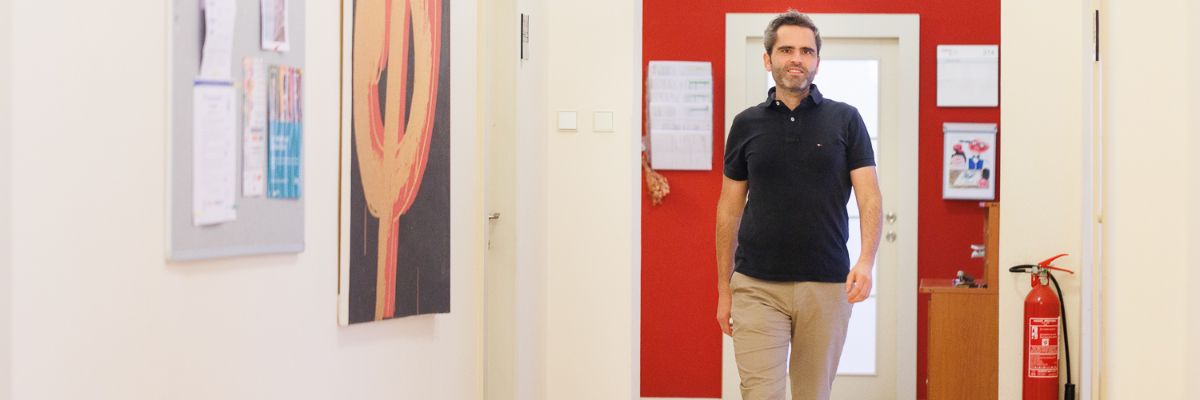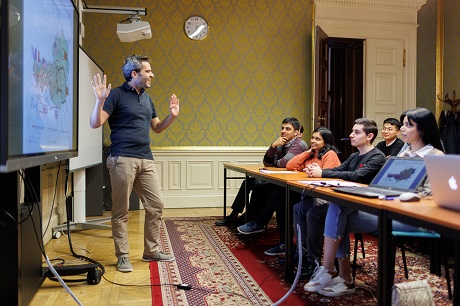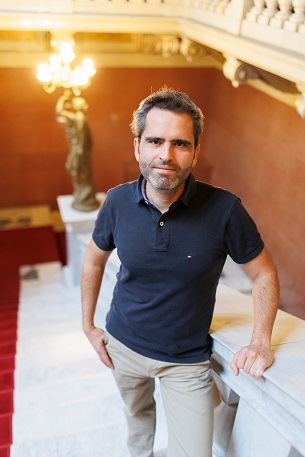
A trapped state: The pandemic impact on public attitudes, trust, and behavior
30. 06. 2025
What happens to public trust when a pandemic hits? Why do some people turn away from health authorities while others become more compliant? In the new CERGE-EI Working Paper titled “Pandemics’ Backlash: The Effects of the 1918 Influenza on Health Attitudes and Behavior,” Christian Ochsner, economist and Assistant Professor at CERGE-EI (the joint workplace of Charles University and the Economics Institute of the Czech Academy of Sciences) explores the long-term effects of pandemic mortality on public health-policy skepticism—using a surprising historical case: The Spanish flu pandemic.
*
In the interview below, Christian explains why some communities resisted state-mandated health measures, including vaccinations after the flu, how individual versus indirect exposure changed attitudes, and what modern policymakers can learn from these patterns. His findings reveal a crucial and timely insight: When a crisis strikes, the state often finds itself in a no-win situation—caught between necessary action, public perception, and long-term backlash.
What inspired you to explore the long-term effects of pandemic mortality on vaccine skepticism?
The idea came from the COVID-19 pandemic. We saw protests, skepticism about vaccines, and pushback against public health measures. This made me think: What shapes our willingness to follow health authorities? Why do some people trust the state to make decisions about things like vaccinations or public health, while others do not? This was the core motivation: To connect the lessons of COVID with a broader question about how societies develop or lose trust in health policies or in state authorities more generally. And we used the Spanish flu pandemic as a historical test case due to very high exposure and unique data.
What exactly did you find?
We looked at data from Switzerland, which gives us a rare opportunity: Swiss citizens vote regularly on specific policies, including health-related issues. In 1922, just a few years after the Spanish flu pandemic, they voted on whether to keep mandatory smallpox vaccination for children. By comparing localities that were more or less affected by the Spanish flu pandemic, we could see how the shock influenced voting behavior. Interestingly, communities that were more heavily hit by the flu later voted against state-mandated vaccination—despite the vaccine being for a different disease (smallpox), and despite it having been used for decades. We also looked at actual vaccination records. The same pattern showed up: In areas more severely affected by the flu, vaccination rates among children dropped. So, overall, being hit harder by the flu led to more skepticism about public health policies.
That seems counterintuitive. You would think more exposure would lead to greater caution.
Exactly. So we went a step further. We linked individual children in the vaccination records with family names in the flu death records to find out whether their families had been directly affected. And this is where the story gets more nuanced. Families that lost someone to the flu increased their compliance with vaccination campaigns. So while communities that observed others dying became more skeptical, personally affected families became more cautious and risk-averse.
“If you directly suffer a loss, you become more careful. You either trust the vaccine or at least you do not change your pre-flu vaccination behavior. But if you only observe others suffering—and feel the state didn’t protect them—you become more skeptical.”

Christian Ochsner is an Assistant Professor and researcher at CERGE-EI, the joint workplace of Charles University and the Economics Institute of the Czech Academy of Sciences.
So whether trust goes up or down depends on how people experienced the shock?
Yes, that’s the key finding. If you directly suffer a loss, you become more careful. You either trust the vaccine or at least you do not change your pre-flu vaccination behavior. But if you only observe others suffering—and feel the state didn’t protect them—you become more skeptical. You think: If they couldn’t protect my neighbor, why should I trust them to protect me? We call this the difference between direct and indirect exposure. And it helps explain the paradox of how a health crisis can create both stronger compliance and rising resistance at the same time.
What was the approach you used to measure it?
We used a quasi-experimental approach. Some Swiss municipalities were hit hard—up to 9% of the population died in just a few months—while others nearby were barely affected. Before the flu, these places were similar in terms of voting behavior and vaccination rates. So the flu exposure was, in effect, arguably random. That gives us confidence that the differences we see afterward are caused by the flu’s uneven impact, not by other factors.
Do you see parallels with what happened during COVID-19?
Even though we don’t yet have data to do the same kind of analysis for COVID, there are suggestive patterns. Countries with higher COVID mortality often saw declines in routine vaccinations, like measles. At the same time, people who were personally affected—those who lost family members or suffered from long COVID—tended to support vaccination more strongly. The societal backlash after COVID and in our setting is not the majority, but even a small shift—from 5% to 10% vaccine skepticism—can matter for herd immunity.
What can policymakers learn from your findings?
First, authorities need to understand that trust can erode quickly during or after a crisis—even when it’s not their fault. If people feel the state failed to protect them or their community, they may stop trusting its guidance, including on vaccines. Second, the effects can last for years. In our data, the drop in vaccination compliance lasted around 12 years after the Spanish flu pandemic. So this isn’t just about short-term crisis management. It’s about long-term credibility. Finally, there’s a dilemma. The state can avoid backlash if it prevents any suffering—but that’s rarely possible. Or it could wait until nearly everyone has a personal loss—which is obviously unacceptable. We estimated that to shift people back to compliance purely through direct exposure, a pandemic would need a mortality rate of 4% to 5%. COVID was around 0.3%. So that’s not a solution either.
“When something big and visible goes wrong, the institutions in charge—whether it’s the health authority, the central bank, or the government—can only lose. Their credibility tends to decline simply because the crisis happened on their watch.”
So when the state acts during a crisis, it is essentially in a no-win situation.
The key idea is that when the state takes action in response to an urgent situation—like rising inflation or a public health emergency—it’s very difficult for it to come out looking good. When something big and visible goes wrong, the institutions in charge—whether it’s the health authority, the central bank, or the government—can only lose. Their credibility tends to decline simply because the crisis happened on their watch. Unless you’re speaking to someone who was personally and positively affected—say, someone who received early treatment or a life-saving vaccine—the general public reaction is often one of skepticism.
And it opens the door for alternative figures or parties to step in.
In the absence of a major crisis, certain individuals with fringe views—like vaccine skeptics or those who fundamentally distrust science—might never gain mainstream attention. But in the aftermath of a crisis, these figures can become much more visible, sometimes even influential. Someone who would have seemed unelectable or unqualified under normal conditions might suddenly find an audience. That’s why the word “backlash” captures the post-pandemic reaction so well; it’s about an erosion of trust that may create space for a very different political and social climate.
Christian Ochsner is an Assistant Professor at CERGE-EI, and a Research Associate at SIAW (University of St. Gallen) as well as a CESifo Research Affiliate. His research explores how critical historical events shape long-term socio-economic outcomes, using quasi-experimental methods that bridge development, regional, political, and health economics.

Study: Ochsner Christian and Lukas Schmid. June 2025. Pandemics’ backlash: The effects of the 1918 influenza on health attitudes and behavior, CERGE-EI Working Paper.
You can also listen to an episode of the Talking Economics podcast where Christian Ochsner talks about regional economics.
Source of text: Lenka Miklánková, CERGE-EI blog post from 11 June 2025
Photo: CERGE-EI
Read also
- Twenty years of EURAXESS: Supporting researchers in motion
- Researching scent: Cleopatra’s legacy, Egyptian rituals, and ancient heritage
- The secret of termites: Long-lived social insects that live in advanced colonies
- Two ERC Synergy Grants awarded to the Czech Academy of Sciences
- Nine CAS researchers received the 2025 Praemium Academiae and Lumina Quaeruntur
- Step inside the world of research: Week of the Czech Academy of Sciences 2025
- A / Magazine: Bugs, the rusting human body, and beauties from the kingdom of ice
- PHOTO STORY: The invasive black bullhead catfish threatens Czech fishponds
- Rewrite the textbooks – we’ve found a bone; aka When science takes a wild turn
- CAS researchers receive L’Oréal-UNESCO Award and Forbes recognition
The Czech Academy of Sciences (the CAS)
The mission of the CAS
The primary mission of the CAS is to conduct research in a broad spectrum of natural, technical and social sciences as well as humanities. This research aims to advance progress of scientific knowledge at the international level, considering, however, the specific needs of the Czech society and the national culture.
President of the CAS
Prof. Eva Zažímalová has started her second term of office in May 2021. She is a respected scientist, and a Professor of Plant Anatomy and Physiology.
She is also a part of GCSA of the EU.